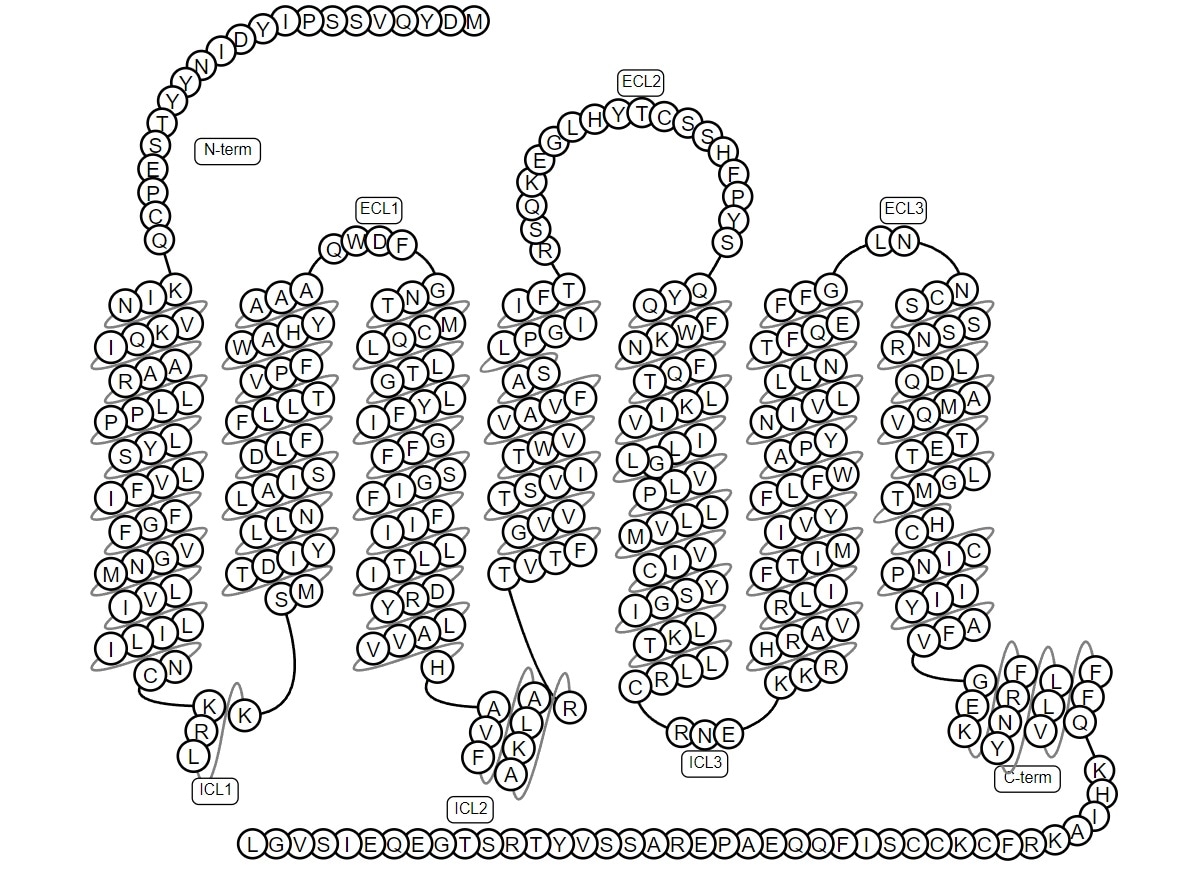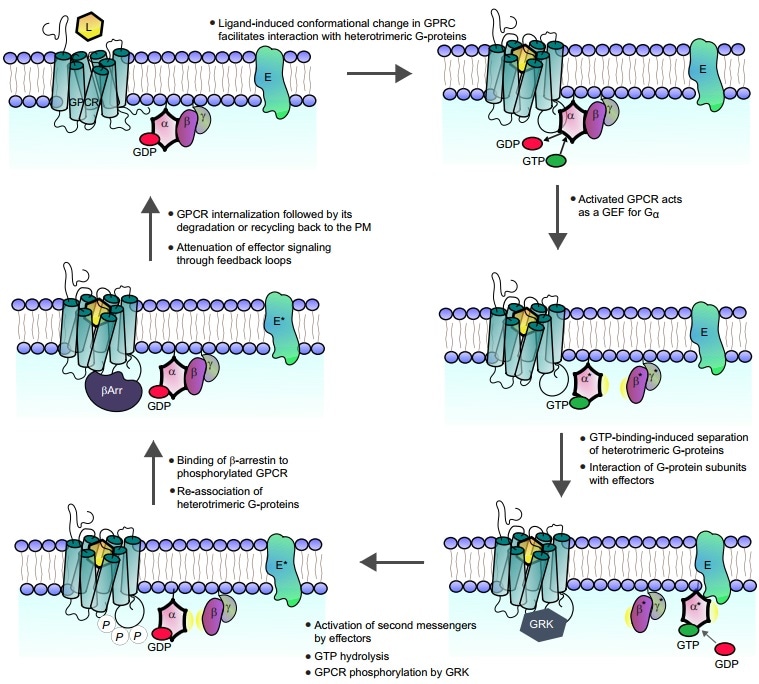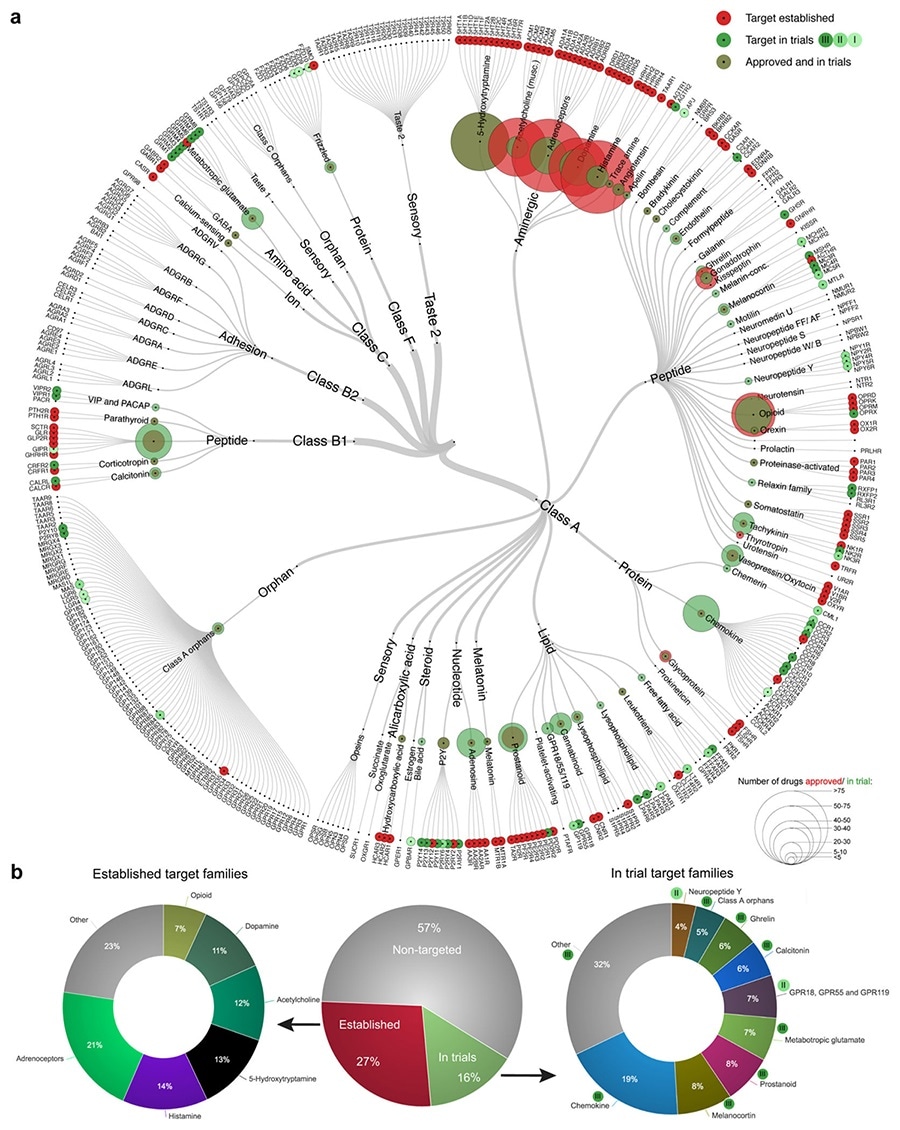A number of membrane proteins that are present on the cell membrane control external and internal material transportation, cell protection and signal transmission. The diversity of functions of membrane protein has also rendered it a key target in drug development.
Over 50% of the drugs that are presently approved target human membrane proteins. G protein-coupled receptors (GPCRs) are the largest group of membrane proteins.
The key work of GPCRs is to transduce an extensive and varied array of extracellular stimuli like biogenic amines, hormones, peptides, neurotransmitters, odorants, ions and photons into intracellular signals that control numerous physiological processes, such as cell differentiation, cell metabolism, neurotransmission, growth, and sensory perception.
GPCRs have also been involved in many diseases, such as type 2 diabetes mellitus (T2DM), Alzheimer’s disease, cancer, obesity, depression and many others. Thus, GPCRs have become the most effective drug target class in drugs targeted for the treatment of a range of diseases.
In this article, signaling pathways, the structure of GPCRs and the development pattern of different stages of targeted drugs are covered. For scientists exploring GPCRs, ACROBiosystems resolves the problems of GPCRs antigen preparation and can offer full-length GPCRs antigen to assist antibody creation.
Structure of GPCRs
The typical molecular structure of GPCRs comprises seven transmembrane alpha helices, and these domains split the receptor into intracellular C-terminus, extracellular N-terminus, three intracellular loops and three extracellular loops.
The extracellular ring has two extremely conserved cysteine residues, which can steady the spatial structure of the receptor by developing disulfide bonds. There is a G-protein binding area on the intracellular loop. With regard to CCR5, the standard GPCRs topology is illustrated in Figure 1 below.

Figure 1. Schematic diagram of the classic GPCRs. Image Credit: ACROBiosystems
The GPCRs signaling pathways
The effectors of GPCR activation include the heterotrimeric G-proteins Gα, Gβ and Gγ. Activated GPCRs serve as guanine-nucleotide-exchange factors (GEFs) and exchange GDP for GTP in the Gα subunit, which triggers the protein.
In its basal condition, a GPCR is without ligand (L). Gα binds to GDP and relates to Gβγ. The heterotrimeric protein complex might relate to the receptor at this point, or stay free in the membrane as seen, but once it meets a ligand-bound GPCR, downstream signaling begins (see Figure 2).

Figure 2. GPCRs signal pathway. Image Credit: ACROBiosystems
Upon ligand binding, the GPCR becomes stimulated and experiences a conformational change. The subsequent GTP-bound Gα splits from βγ, and the heterotrimeric proteins are active.
Now, the GDP-αβγ complex, with the involvement of Mg2+, exchanges GTP in the bound GDP with the cytosol to develop a GTP-αβγ complex.
Then, the G protein is triggered and divided from the receptor, and at the same time, disassembled into two components, GTP-α and βγ, which diffuse spontaneously along the cell membrane and directly interrelate with effector proteins, such as PLC or adenylate cyclase, which causes effector stimulation and commencement of a second-messenger cascade and finishes the transmission of extracellular signals into the cell.
The GTP in Gα is then hydrolyzed to GDP via the activity of Gα and RGS proteins (not illustrated), resulting in Gα inactivation and reassociation of the heterotrimeric protein complex. This process signifies a complete GPCR G-protein cycle.
Progress in drug development targeting GPCRs
Changing the competitive landscape
GPCRs are the most comprehensively researched drug targets. Drugs that aim for GPCRs comprise approximately 27% of the international market share of therapeutic drugs, with combined sales for 2011–2015 of ~US$890 billion. The 227 (57%) non-olfactory GPCRs that are yet to be investigated in clinical trials have wide-ranging unexploited therapeutic potential, mainly in immune and genetic system disorders.
In 2017, survey data revealed that there were 481 therapeutic drugs targeting GPCRs, which have added to 34% of FDA approvals and interceding their effects via no less than 107 distinctive GPCRs. About 320 drugs are presently in clinical trials, of which 35% target 64 possibly unique GPCR targets.
In the domain of drug development that targets GPCRs, GPCR antibodies possess exclusive benefits over small molecule drugs:
- For instance, the body’s clearance rate is lower, action time is longer and the equivalent frequency of administration is lower
- The selectivity of antibodies is considerably superior to that of small molecules
- However, because of the obstruction of the blood-brain barrier, antibody drugs cannot penetrate the central nervous system. So, for GPCRs that are expressed in the peripheral as well as the central nervous systems, only the peripheral part of the drug needs to be engineered, therapeutic antibodies can be created to make mainly distribute the drug in the peripheral area and cut out the toxic side effects on the central nervous system.

Figure 3. GPCRs clinical drug target distribution. Image Credit: ACROBiosystems
Overview of leading projects
There are presently nearly 13 GPCRs targeted antibody projects under development that are active globally, as illustrated in the table below. The target is chiefly concentrated in GPR49, CALCRL, CCR4, CCR5, GLP1R, GCGR, GPRC5D, CB1, S1PR1, C5AR, CCR8, CCR7 and AGTR1.
The more characteristic drug is Leronlimab, a humanized IgG4 monoclonal antibody targeting CCR5, which is an HIV viral entry inhibitor. By covering CCR5, the HIV (R5) subtype is obstructed from penetrating healthy T cells, thereby defending these cells from viral contagions.
Table 1. Targeted GPCRs drug information under research (CLARIVATE Database). Source: ACROBiosystems
| Drug Name |
Target |
Organization |
Highest Phase |
Condition |
| Mogamulizumab |
CCR4 |
Kyowa Hakko Kirin |
Launched |
Lymphoma Therapy |
| Eptinezumab |
CGRPR |
Alder Biopharmaceuticals |
Launched |
Acute Attacks of Migraine |
| Leronlimab |
CCR5 |
Beth Israel Deaconess
Medical Center |
Pre-Registered |
Anti-HIV Agents |
| Volagidemab |
GCGR |
Amgen |
Phase II |
Type 2 Diabetes, |
| Talquetamab |
CD3, GPRC5D |
Janssen |
Phase II |
Multiple Myeloma Therapy |
| GMA102 |
GLP1R |
Gmax Biopharm |
Phase II |
Type 2 Diabetes |
| Neutrazumab |
C5AR |
Garvan Institute |
Phase II |
Antiarthritic Drugs |
| Nimacimab |
CB1 |
Bird Rock Bio |
Phase II |
Diabetic Nephropathy |
| Sonepcizumab |
S1PR1 |
Pfizer & Merck Serono |
Phase II |
Age-Related Macular Degeneration |
| BMS-986340 |
CCR8 |
Bristol-Myers Squibb |
Phase I/II |
Solid Tumor Treatments |
| JBH492 |
CCR7 |
Novartis |
Phase I |
Lymphocytic Leukemia Therapy |
| MCLA-158 |
EGFR, GPR49 |
Merus |
Phase I |
Colorectal Cancer Therapy |
| NA |
AGTR1 |
Huazhong University of Science and Tech |
Preclinical |
Antidiabetic Drugs |
ACROBiosystems assists in the development of targeted GPCR antibodies
The initial step in preparing antibodies is antigen immunity, and the initial step in immunity is antigen preparation. Since GPCRs are seven-pass transmembrane proteins, it is very challenging to attain biologically active soluble GPCRs antigen.
To gain a full-length GPCR antigen for drug creation, two bottlenecks need to be broken:
- How to boost the expression?
The expression of a majority of membrane proteins on the cell membrane is tiny, and some are only expressed for a brief period of time during a particular phase of the cell cycle. Simultaneously, in contrast to secretory proteins, the expression and display of membrane proteins are restricted by the membrane area.
Furthermore, since several membrane proteins involve tasks associated with material transport and signaling, overexpression on the cell membrane can result in permanent damage to cells. These features of membrane proteins significantly restrict their expression.
Thus, to acquire sufficient full-length membrane proteins for immunity and drug development, it is essential to engineer and enhance the expression system, expression interval, culture conditions, etc. Even so, the cost of attaining milligram membrane proteins is still a lot higher than that of soluble proteins.
- How to maintain the consistency and activity of membrane proteins throughout expression and purification?
The transmembrane domain of membrane proteins is very hydrophobic, so unshielded exposure to water will result in nonspecific protein aggregation and even denaturation. Thus, in the method of enrichment and refining of membrane proteins, it is essential to always maintain the hydrophilic features of the immediate environment of membrane proteins.
The most used technique is to eliminate membrane proteins from the cell membrane of the phospholipid bilayer via detergent and develop micelles to keep their inherent conformation and functional activity as much as possible. Simultaneously, there are also approaches such as virus-like particles (VLP), Nanodisc, polymer lipid particles (PoLiPa).
Thus, to match the requirements of various applications in the drug development process that targets GPCRs, ACROBiosystems has specifically created platform solutions with Micelle Detergent, VLP and Nanodisc to offer full-length GPCRs proteins such as CCR5, GPRC5D, CCR8, etc.
Table 2. GPCRs related products available from ACROBiosystems. Source: ACROBiosystems
| Platform |
Molecule |
Cat. No. |
Production Discription |
| VLP Platform |
GPRC5D |
GPD-H52P5 |
Human GPRC5D Full Length Protein-VLP (HEK293) |
| CCR5 |
CC5-H52P3 |
Human CCR5 Full Length Protein-VLP (HEK293) |
| CCR8 |
CC8-H52P4 |
Human CCR8 Full Length Protein-VLP (HEK293) |
| VLP |
VLP-H52C5 |
Virus-Like Particle (VLP) isotype control |
| Micelle Detergent Platform |
GPRC5D |
GPD-H52D3 |
Human GPRC5D Protein, Flag, His Tag |
| CCR5 |
CC5-H52D1 |
Human CCR5 Protein, Flag, His Tag |
| Buffer |
DC-11 |
200 x DDM CHS buffer |
| Nanodisc Platform |
GPRC5D |
GPD-H52D4 |
Human GPRC5D Protein, Flag, His Tag (Nanodisc) |
| GPRC5D |
GPD-H82D4 |
Biotinylated Human GPRC5D Protein, His, Avitag™&Flag Tag (Nanodisc) |
| MSP1D1 |
APO-H51H3 |
Human MSP1D1 Protein, His Tag (Nanodisc) |
| MSP1D1 |
APO-H81Q5 |
Biotinylated Human MSP1D1 Protein, His, Avitag™ (Nanodisc) |
Besides GPCRs, ACROBiosystems can deliver a full range of full-length multi-pass transmembrane proteins, including Claudin18.2, four-pass transmembrane protein CD20 and five-pass transmembrane protein CD133. Additional full-length proteins are in progress.
About ACROBiosystems
ACROBiosystems is a cornerstone enterprise of the pharmaceutical and biotechnology industries. Their mission is to help overcome challenges with innovative tools and solutions from discovery to the clinic. They supply life science tools designed to be used in discovery research and scalable to the clinical phase and beyond. By consistently adapting to new regulatory challenges and guidelines, ACROBiosystems delivers solutions, whether it comes through recombinant proteins, antibodies, assay kits, GMP-grade reagents, or custom services. ACROBiosystems empower scientists and engineers dedicated towards innovation to simplify and accelerate the development of new, better, and more affordable medicine.
Sponsored Content Policy: News-Medical.net publishes articles and related content that may be derived from sources where we have existing commercial relationships, provided such content adds value to the core editorial ethos of News-Medical.Net which is to educate and inform site visitors interested in medical research, science, medical devices and treatments.